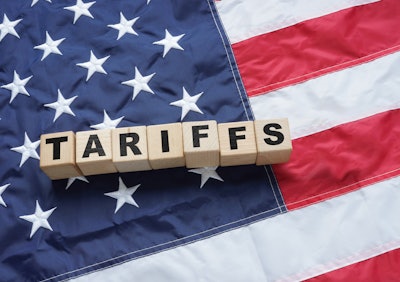
On April 2, President Trump announced a sweeping and encompassing global tariff, paired with reciprocal tariffs on a list of nearly 60 countries.
This dwarfs the measures implemented by his first administration and pushes U.S. trade barriers to their highest levels since the 1930s
The bottom line
Global tariffs of 10% will go into effect April 5 while reciprocal tariffs will be applied starting April 9. The president also issued a separate order that will suspend de minimis exemption eligibility for all Chinese goods starting May 3.
The rundown
Citing the U.S. trade deficit in goods as a threat to national security, President Trump made broad use of executive powers granted by the International Emergency Economic Powers Act (IEEPA) to enact the new tariffs. The executive order for these actions states that the tariffs are aimed at the (sometimes competing) goals of removing foreign barriers to U.S. exports and creating barriers to foreign imports, both as ways to increase or restore domestic manufacturing.
The global tariff of 10%, which will not apply to countries targeted for reciprocal tariffs, will go into effect for all goods not yet in transit by April 5. As the order states:
“Except as otherwise provided in this order, all articles imported into the customs territory of the United States shall be, consistent with law, subject to an additional ad valorem rate of duty of 10 percent. Such rates of duty shall apply with respect to goods entered for consumption, or withdrawn from warehouse for consumption, on or after 12:01 a.m. eastern daylight time on April 5, 2025.”
Reciprocal tariffs on exports from a list of nearly 60 countries range from a level of 11% for Congo to 50% for Lesotho. These duties will be applicable to all exports not loaded by April 9.
The newly announced tariffs join steel and aluminum tariffs, a 25% tariff on all automotive imports, and a 25% tariff on any country that purchases oil from Venezuela already in effect, though only the Venezuelan tariff will be stacked on top of global or reciprocal tariffs.
Reciprocal tariffs
As calculated, the reciprocal tariffs were likely arrived at by dividing the value of the given country’s trade imbalance with the United States by how much the U.S. imports from that country.
For China, this calculation resulted in a 34% reciprocal tariff, which when applied on top of the 20% tariff on all Chinese goods Trump introduced earlier in the year, brings the base rate for all Chinese imports into the United States to 54%. Specific goods already targeted with other tariffs from earlier Trump or Biden moves could face tariffs of more than 70%. The Venezuelan oil tariff could even be applied on top of that.
These steps dwarf the first round of the Trump trade war from 2018-2020, when the overall tariff rate on Chinese goods was less than 20% and applied to a maximum of two-thirds of all Chinese exports.
And as Trump’s first administration focused mostly on China, it accelerated many shippers’ shift to a China+1 strategy. This trend was apparent in the increases in U.S. trade with Mexico and Canada, and with alternatives in Asia like Vietnam, India, Taiwan and Bangladesh, at the expense of Chinese imports to the United States, which declined from 20% of total U.S. imports in 2018 to 13% in 2024.
This time though, in addition to the 10% global rate, the reciprocal tariffs make these alternatives much less attractive. For example, goods from the below countries – some of the major China alternatives – will meet accelerated tariffs:
- Vietnam: 46%
- India: 27%
- Bangladesh: 37%
- Cambodia: 49%
Canada, Mexico and automotive
This week’s order excludes Canada and Mexico from global or reciprocal tariffs. President Trump introduced and then paused a 25% tariff on all goods from these neighbors in February, and then in March, applied it only to goods not included in the USMCA.
The 25% rate was meant to start applying to USMCA-covered goods too on April 2, but the executive order states that USMCA goods will continue to be exempted, without specifying an expiration for this carve out.
In late March, Trump signed an executive order that applies 25% tariffs to all automotive imports starting April 3. This tariff will be instead of, not in addition to, the global or reciprocal tariff. And though automotive imports are a significant share of intra-North America trade and will be applied to imports from Canada and Mexico, these countries will only pay the 25% rate on the value of the non-U.S. components in the vehicle or item.
Exemptions for U.S. value created
Imports from any country for which at least 20% of its value originated in the United States will only pay the global or reciprocal tariff for the non-U.S. value of the goods. And steel and aluminum are subject to the existing global tariff levels instead of the global or reciprocal tariffs with copper, pharmaceuticals, semiconductors, lumber articles, certain critical minerals, and energy and energy products also not subject to the new tariffs. But the president has expressed interest in applying sectoral tariffs for some of these, possibly soon.
Retaliation, removal and uncertainty
The order states that the United States will respond by further raising tariffs for any country that retaliates by applying new tariffs on U.S. exports. The EU has already stated that it will retaliate nonetheless, as has Canada. China has retaliated to Trump’s earlier tariffs and recently stated that it will respond in conjunction with Japan and South Korea.
The text continues though, that the United States could reduce or remove tariffs if the president decides that a country has taken significant steps to remove their barriers to U.S. exports.
The removal of foreign barriers would increase access for U.S. exports to foreign markets, but they would also increase foreign export access to the United States, which would work against Trump’s stated goal of increasing manufacturing by blocking foreign competition.
Stating that foreign concessions could make these tariffs subject to change further adds to the uncertainty and difficulty for U.S. and foreign importers and exporters to invest in significant changes to their trade strategies just yet.
De minimis
The U.S. de minimis exception allows U.S. imports worth $800 or less to enter the country duty-free, has minimal customs filing requirements and costs, and lets imports of this time speed through customs.
This rule has been a major driver of the surge of several million packages a day arriving via de minimis into the United States, mostly B2C e-commerce goods from China, and mostly arriving by air cargo.
Opposition to this trend has been widespread, including from the Biden administration, due to claims of facilitating unfair competition, enabling the flow of illicit goods or evading scrutiny of goods possibly made through forced labor.
Focusing on de minimis as an avenue for fentanyl smuggling, Trump had suspended de minimis eligibility in the same executive order that applied the first tariff increase on Chinese goods in February.
This rule change took nearly immediate effect following the order in February. But the resulting jump in parcels requiring formal entry quickly overwhelmed U.S. Customs and Border Protection, and led to Trump’s quick reinstatement of de minimis eligibility for Chinese imports.
The reciprocal tariff order states that the president will keep de minimis in place for Canada and Mexico until the USCB develops the adequate systems needed to handle these parcels as formal entries.
Nonetheless, Trump’s other executive order signed April 2 states that adequate systems are in place to handle imports from China and therefore he will suspend de minimis eligibility for all Chinese goods starting May 2. From then, all low-value Chinese imports shipped to the United States will be subject to all formal entry filing requirements, costs, and all U.S. tariffs that apply to China.
Shippers sending goods by postal service will have to choose between paying a 30% tariff or a $25 fee per parcel, which will climb to $50 June 1.
Economic implications of Trump tariffs
There is really no comparing Trump’s trade war this year with the steps he took starting in 2017.
Besides relying much more heavily on emergency powers instead of the more established trade laws presidents have used for tariff implementations in the past, the scope of the current duty roll outs are far larger in terms of the level of tariffs on China and in terms of the extremely high levels being applied to the rest of the U.S.’s trading partners.
Trade – even the U.S.’s importing activity – continued to grow since 2017 even if trade flows shifted. Intra-Asia trade has climbed as other Asian countries increased manufacturing for the U.S. market, and China-Mexico trade surged as China invested heavily in Mexico as an alternate route to the U.S. market.
This time though, the tariffs are so broad and high that there are few duty-free alternatives. In other words, U.S. import costs will inevitably go up. Retaliatory tariffs will also mean that demand for U.S. exports is likely to drop, negatively affecting U.S. agriculture and manufacturing.
Price increases to imports, which often also result in higher prices from domestic manufacturers too will mostly be passed on and felt by consumers, which could increase the inflation rate and depress consumer spending.
Most economists are now predicting slower and modest U.S. GDP growth, an increased likelihood of recessions in the United States and beyond, and therefore a possible contraction of global trade as well. If things do play out this way, the freight market will suffer too.
Freight implications of Trump tariffs
Air cargo
There have already been signs that Trump’s brief pause of de minimis for China in February accelerated Chinese e-commerce platforms’ initiatives to shift away from a reliance on de minimis and air cargo.
These companies have moved manufacturing to other countries like Vietnam, increased their use of ocean logistics to North America, and invested in warehousing and fulfillment capabilities in Mexico or even in the United States.
And on the air cargo side there have been multiple reports of canceled China-U.S. BSAs, canceled charters, carriers shifting capacity elsewhere and other signs and expectations of volume decreases resulting from a drop in e-commerce volumes in anticipation of de minimis changes. China–U.S. air cargo spot rates have also eased so far this year, but certainly have not collapsed, remaining much higher than the long-term norm.
A big driver of the brief chaos caused by de minimis for China being suspended in February was the lack of warning. Millions of low-value parcels were already at customs or en route, and quickly overwhelmed USCBP.
But with a one-month runway this time, expect some rush of last-chance demand and then a significant drop right around the May 2 roll out date. This pattern will likely push rates – as well as possible delays and congestion – up in the coming weeks, and then see rates on this lane drop, probably sharply, in May. Even with this change though, some e-commerce will likely still go by air, which could prevent a complete rate collapse.
As capacity is redistributed, we could also see knock-on downward pressure on rates on many other lanes. And if adequate customs systems are actually not in place yet, shippers could also face significant delays in customs warehouses.
The general economic impact of the trade war, of course, could also be a major factor in demand for air cargo and therefore volumes and rates in the near term and beyond.
Ocean freight
The anticipation of new Trump tariffs has driven many U.S. importers to frontload as much inventory as possible since November. This pull forward of demand was one factor that has kept U.S. ocean import container volumes stronger than usual since late last year.
With the reciprocal tariffs not being applied to goods loaded before April 9, expect a very brief scramble that will push container rates and demand up for the next few days.
After that though, many importers who’ve built up inventory are likely to be able to reduce or pause orders and shipments until the tariff dust settles. This move will see container volumes and rates drop, possibly significantly, soon and could be one factor that will cause a very subdued peak season period this year, similar to how a tariff-driven pull forward in 2018 led to somewhat lower container rates and demand in 2019.
Once inventories run down, the strength of the container market will depend on the economic impacts of the trade war. Lower consumer demand will lower demand for freight. And with none of the U.S.’s major sourcing partners spared from significant tariffs this time, containers that do move will come at higher tariff costs to shippers and then for consumers.
These trends will put downward pressure on container rates, which have already been falling globally, despite Red Sea diversions continuing to absorb capacity, and even on the transpacific where frontloading has kept demand relatively strong, as new carrier alliance roll outs have increased competition and fleet growth is already leading to overcapacity. Together these factors could potentially see container rates reach extremely low levels.



















